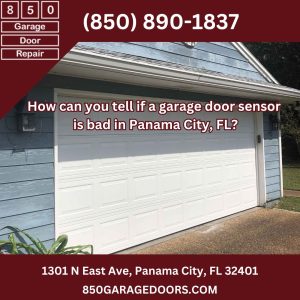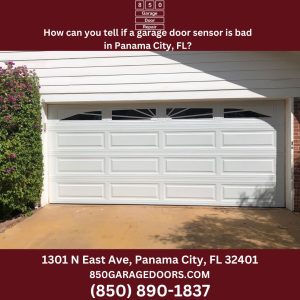
Understanding the Role of Garage Door Sensors
What Do Garage Door Sensors Actually Do?
Garage door sensors are part of your system’s safety mechanism. Positioned near the bottom of each side of the door, they send an invisible beam across the opening. If that beam is interrupted—by a child, pet, object, or even debris—the sensors signal the opener to stop closing or reverse the door to prevent injury or damage.
Safety Importance in Florida Homes
With families, frequent visitors, and pets coming and going, garage door sensors are essential in protecting what matters most. In Florida homes, where garages are often entry points, reliable sensor operation ensures smooth daily routines and peace of mind.
Why Panama City’s Climate Can Affect Sensor Performance
Panama City’s humid air, salt-laden breezes, and intense summer storms can accelerate wear on electronic components. Sensors that might last years in dry climates may fail earlier in coastal Florida, making periodic checks more important for local homeowners.
Common Signs of a Faulty Garage Door Sensor
The Door Won’t Close All the Way
If your garage door begins to close but suddenly stops or reverses with no visible obstacle, the sensors may be out of alignment or malfunctioning.
Blinking or No LED Lights on the Sensors
Most sensors have LED lights that show their working status. A blinking light usually indicates misalignment or obstruction, while no light at all might point to wiring or power issues.
Door Reverses Immediately After Closing
If the door touches the ground then quickly lifts back up, this can signal a sensor miscommunication or failure in detecting a clear path.
Intermittent Operation or Delayed Response
When the garage door opens or closes inconsistently, especially during certain weather conditions, it might be a sign of weakening sensor components.
Garage Door Only Closes When Holding the Wall Button
This is a major indicator. If the door only shuts when you hold down the wall control, the sensor beam is likely being blocked or the sensors are failing altogether.
How to Inspect Garage Door Sensors Yourself
Check for Obstructions and Dirt
Leaves, spider webs, dust, or even small items can block the sensor beam. Start by clearing the area around the sensors.
Cleaning Sensor Lenses Properly
Use a soft, damp cloth to gently wipe the lenses. Avoid using harsh cleaners or rough towels, as these may scratch or damage the sensors.
Confirm Sensor Alignment
Misaligned sensors can’t “see” each other and will trigger safety features. Each sensor should face directly toward the other, parallel and level.
How to Realign Garage Door Sensors Safely
Loosen the mounting brackets and slowly adjust until the LED lights stay steady—usually green. Then re-tighten while maintaining the alignment.
Inspect the Wiring and Mounting Brackets
Check for loose wires, corrosion, or physical damage. Also make sure the brackets holding the sensors are stable and not cracked or bent.
Use the LED Light Test to Spot Problems
Most modern sensors have a solid light when functioning. Blinking or no lights suggest problems with alignment, power, or internal circuitry.
What Causes Garage Door Sensors to Fail in Panama City?
Humidity and Salt Air Corrosion
High moisture and salty air can corrode wiring and circuit boards over time, leading to intermittent or total sensor failure.
Storm-Related Electrical Surges
Florida’s frequent lightning storms can cause power surges that damage sensitive electronic components like sensors and openers.
Physical Damage from Equipment or Pets
Lawn tools, bicycles, or even pets running through the garage can bump or hit the sensors, knocking them out of alignment or breaking them completely.
Wear and Tear Over Time
Even with no visible damage, electronic components degrade. Sensors that are several years old may simply stop working as expected.
When to Call a Professional in Panama City
DIY Fixes vs. Expert Inspection
While some sensor issues can be resolved with cleaning or realignment, other cases—like internal wiring failures or damaged brackets—require a technician. If you’ve gone through basic troubleshooting and the problem persists, it’s best to bring in a pro.
The Risks of Ignoring a Sensor Malfunction
Bypassing or ignoring a faulty sensor can lead to door damage, personal injury, or legal issues if an accident occurs. It also leaves your garage vulnerable to unauthorized access.
Preventive Tips to Keep Sensors Working Longer
Regular Maintenance Checklist
Just like any home component, garage door sensors benefit from a little attention. Add them to your seasonal maintenance routine to catch problems early.
| Preventive Maintenance Tip | Why It Matters |
|---|---|
| Wipe sensor lenses monthly | Removes dirt, ensuring the beam remains unobstructed |
| Check alignment every season | Prevents accidental miscommunication between sensors |
| Inspect wires and mounting brackets | Identifies corrosion or damage early before failure |
| Test garage door with wall button weekly | Confirms sensors are working and safety functions are intact |
| Clear debris after storms | Protects sensors from blockage and impact |
Protecting Garage Sensors from Storm Damage
Using surge protectors and elevating wiring off the garage floor can reduce the risk of storm-related damage. Also, be mindful of any debris buildup following a storm or hurricane.

Final Thoughts
Don’t Wait for a Total Failure
Sensor issues rarely fix themselves. Addressing early signs can prevent more serious problems and keep your garage door system running safely.
Safe, Functional Doors Start with Reliable Sensors
Garage door sensors play a quiet but critical role in your home’s safety and convenience. If you’re unsure whether your sensors are working properly, or if you’re tired of guesswork, it’s time to consider a professional evaluation.
To keep your garage door system in peak condition, trust the experienced team at 850 Garage Doors. Visit www.850garagedoors.com to learn more or schedule a service today.

